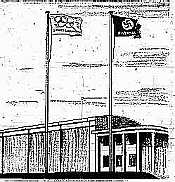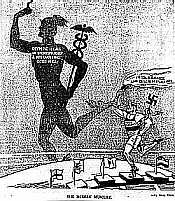|
|
|
|
Debate over participation in the 1936 Olympics was greatest in the United States, which traditionally sent one of the largest teams to the Games. By the end of 1934, the lines on both sides were clearly drawn. Avery Brundage, president of the American Olympic Committee, opposed a boycott, arguing that politics had no place in sport. His rival, Judge Jeremiah Mahoney, president of the Amateur Athletic Union, pointed out that Germany had broken Olympic rules forbidding discrimination based on race and religion. In his view, participation would mean an endorsement of Hitler's Reich.
|

 A cartoon titled “The Paradox”, in The Brooklyn Daily Eagle, August 3, 1936. It shows Olympics and Nazi flags flying over a sports stadium. —Brooklyn Collection, Brooklyn Public Library
|

A cartoon titled “The Paradox”, in The Brooklyn Daily Eagle, August 3, 1936. It shows Olympics and Nazi flags flying over a sports stadium. —Brooklyn Collection, Brooklyn Public Library
|

 This cartoon, “The Modern Mercury” by Jerry Doyle, appeared in The Philadelphia Record, December 7, 1935. The faded large figure in the background bears the label “Olympics ideals of sportsmanship and international good will.” The image of Hitler in the foreground bears the words “1936 Olympics,” “Intolerance and discrimination,” and “Nazism.” —USHMM #21789/Provided by the Historical Society of Pennsylvania
|

This cartoon, “The Modern Mercury” by Jerry Doyle, appeared in The Philadelphia Record, December 7, 1935. The faded large figure in the background bears the label “Olympics ideals of sportsmanship and international good will.” The image of Hitler in the foreground bears the words “1936 Olympics,” “Intolerance and discrimination,” and “Nazism.” —USHMM #21789/Provided by the Historical Society of Pennsylvania
|
|
The Museum’s exhibitions are supported by the Lester Robbins and Sheila Johnson Robbins Traveling and Special Exhibitions Fund, established in 1990.
|
